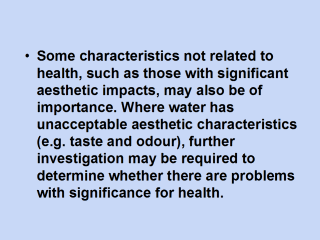| front |1 |2 |3 |4 |5 |6 |7 |8 |9 |10 |11 |12 |13 |14 |15 |16 |17 |18 |19 |20 |21 |22 |23 |24 |25 |26 |27 |28 |29 |30 |31 |32 |33 |34 |35 |36 |37 |38 |39 |40 |41 |42 |43 |44 |45 |46 |47 |48 |49 |review |
 |
The management
plans developed by water suppliers are best termed a Water Safety Plan
(WSP). A WSP comprises system assessment and design, operational monitoring,
and management plans including documentation and communication.
The plans should address all aspects of the water supply and focus on the control of water production, treatment and delivery of drinking-water. The control of microbial and chemical quality of drinking-water requires the development of WSPs which, when implemented, provide the basis for system protection and process control to ensure that numbers of pathogens and concentrations of chemical present a negligible risk to public health. Many drinking-water supplies provide adequate, safe, drinking-water in the absence of formalised WSPs. A major benefit of developing and implementing a WSP for these supplies is the systematic and detailed assessment and prioritisation of hazards and the operational monitoring of barriers or control measures. This process ensures that safe water is continually supplied and that contingency plans are in place to respond to system failures or hazardous events. Health-based targets Health-based targets provide the basis for the application of the Guidelines to all types of water supply. Constituents of drinking-water may cause adverse health effects from either single (e.g. microbial pathogens) or long-term exposures (e.g.non-threshold genotoxic chemicals) or longer-term or multiple exposures (in the case of chemicals which have a threshold of effect). Due to the range of constituents in water, their mode of action, and nature of fluctuations of concentrations in drinking-water, there are four principal types of health-based targets used as the final requirement for safety of drinking-water all based on Health outcome targets: Health outcome targets: In some circumstances, especially where there is a measurable burden of disease, a significant proportion of which is water-related/water-borne, reducing exposure through drinking-water has the potential to appreciably reduce overall risks of disease. In such circumstances it is possible to establish a health-based target in terms of a quantifiable reduction in the overall level of disease. This is most applicable where adverse effects soon follow exposure and are readily and reliably monitored and where changes in exposure can also be monitored readily and reliably. This type of health outcome targets is therefore primarily applicable to some microbial hazards in developing countries and chemical hazards with clearly-defined health effects largely attributable to water (e.g. fluroride). In other circumstances health-based targets may be the basis for evaluation of results of quantitative risk assessment models. In these cases, health outcomes are estimated based on information concerning exposure and dose-response relationships. The results may be employed directly, as a basis to define water quality targets or provide the basis for development of performance and safety targets. Such an approach is currently of limited napplicabilty in practice because of limitations in the available data and models. Specific attention must be given to short term fluctuations in water quality that may be sporadic in nature but may be determining for overall health risks or even the cause of outbreaks. Water quality targets (WQTs) are established for individual drinking-water constituents which represent a health risk from long-term exposure and where fluctuations in concentration are small or occur over long periods. They are typically expressed as Guideline Values (concentrations) of the substances of concern. Performance and safety targets: control measures employed as part of the drinking-water management system for constituents where short-term exposure represents a public health risk, or where large fluctuation in numbers or concentration occur over short periods of time with significant health implications. They are typically expressed in terms of required reductions of the substance of concern or effectiveness in preventing contamination. Directly specified requirements: National regulatory agencies may establish targets for specific actions for smaller municipal and community water supplier. Such targets may identify specific permissable devices or process for given situations and generic drinking water system types. |
| front |1 |2 |3 |4 |5 |6 |7 |8 |9 |10 |11 |12 |13 |14 |15 |16 |17 |18 |19 |20 |21 |22 |23 |24 |25 |26 |27 |28 |29 |30 |31 |32 |33 |34 |35 |36 |37 |38 |39 |40 |41 |42 |43 |44 |45 |46 |47 |48 |49 |review |